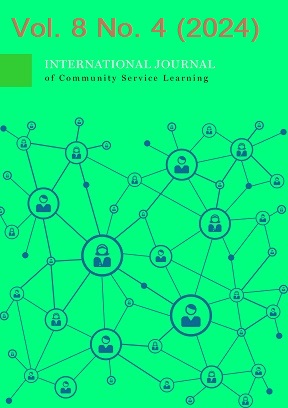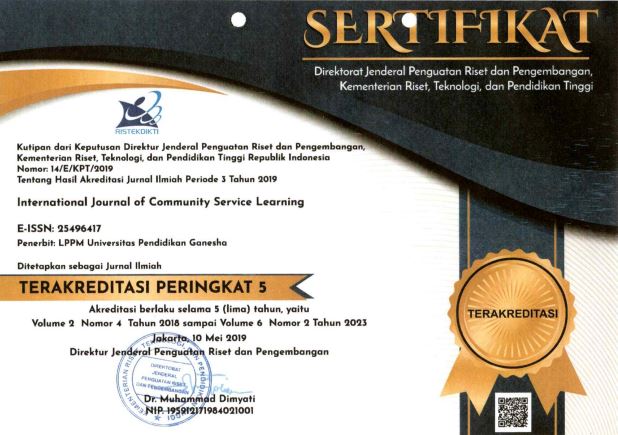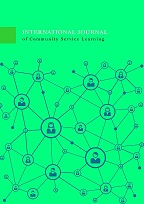Innovation of a Flattening Tool for Optimizing the Water Hyacinth Weaving Process at Maeswara Basket: A Preliminary Study and Technology Implementation
DOI:
https://doi.org/10.23887/ijcsl.v8i4.84505Keywords:
Natural Fiber, Water Hyacinth, Flattening Tool, Technology, Maeswara BasketAbstract
Maeswara Basket faces problems with manual flattening tools that are ineffective in producing crafts from water hyacinth fibre. The proposed solution is developing a flattening tool by considering ergonomics, work safety, speed settings, and primary controls features. This study uses a community-based research (CBR) approach with five stages: problem identification, literature analysis, design planning, manufacturing, and evaluation. Six people assessed the flattening tool based on ease of use, process efficiency, quality of results, and overall evaluation using a Likert scale of 1-5. The results showed that the tool met important criteria such as ergonomics, ease of operation, flattening speed, thickness consistency, quality of results, and component durability, with scores ranging from 4.3 to 4.8 out of 5.0, categorized as "very satisfactory." The new tool excels in ease of use, process efficiency, and quality of results, with the main features of speed settings and controls that maintain the stability of fibre size during the flattening process. This study contributes to the development of products according to community needs. It has the potential to increase the production capacity of water hyacinth artisans, with opportunities for further development using automation technology.
References
Abral, H., Putra, H., Sapuan, S. M., & Ishak, M. R. (2013). Effect of Alkalization on Mechanical Properties of Water Hyacinth Fibers-Unsaturated Polyester Composites. Polymer - Plastics Technology and Engineering, 52(5), 446–451. https://doi.org/10.1080/03602559.2012.748804.
Aisyah, A., & Dartono, F. A. (2022). Studi Kasus Serat Eceng Gondok Pada Produk Kerajinan Di Industri Kreatif Bengok Craft. Ornamen, 19(2), 176–198. https://doi.org/10.33153/ornamen.v19i2.4593.
Ajithram, A., Winowlin Jappes, J. T., Chithra, G. K., & Daphne, R. (2023). Serious environmental threat water hyacinth (Eichhornia crassipes) plant natural fibress: Different extraction methods and morphological properties for polymer composite applications. Materials Today: Proceedings, 1–16. https://doi.org/10.1016/j.matpr.2023.03.431.
Archer, S., De Villiers, C. B., Scheibl, F., Carver, T., Hartley, S., Lee, A., Cunningham, A. P., Easton, D. F., McIntosh, J. G., Emery, J., Tischkowitz, M., Antoniou, A. C., & Walter, F. M. (2020). Evaluating clinician acceptability of the prototype CanRisk tool for predicting risk of breast and ovarian cancer: A multi-methods study. PLoS ONE, 15(3), e0229999. https://doi.org/10.1371/journal.pone.0229999.
Arivendan, A., Jebas Thangiah, W. J., Irulappasamy, S., & N Chrish, B. (2022). Study on characterization of water hyacinth (Eichhornia crassipes) novel natural fiber as reinforcement with epoxy polymer matrix material for lightweight applications. Journal of Industrial Textiles, 51(5_suppl), 8157S-8174S. https://doi.org/10.1177/15280837211067281.
Athaillah, T., Muzammil, A., Fadhiela ND, K., Jayadi, F., Masykur, M., & Azwanda, A. (2023). Pemberdayaan Masyarakat Desa Dalam Mengembangkan Produk Dari Tanaman Eceng Gondok. Media Abdimas, 2(3), 57–63. https://doi.org/10.37817/mediaabdimas.v2i3.3499.
Budiarto, R. (2017). Kinerja Algoritme Pengenalan Wajah untuk Sistem Penguncian Pintu Otomatis Menggunakan Raspberry-Pi. Khazanah Informatika : Jurnal Ilmu Komputer Dan Informatika, 3(2), 80–87. https://doi.org/10.23917/khif.v3i2.5160.
Carver, T., Hartley, S., Lee, A., Cunningham, A. P., Archer, S., de Villiers, C. B., Roberts, J., Ruston, R., Walter, F. M., Tischkowitz, M., Easton, D. F., & Antoniou, A. C. (2021). Canrisk tool—A web interface for the prediction of breast and ovarian cancer risk and the likelihood of carrying genetic pathogenic variants. Cancer Epidemiology Biomarkers and Prevention, 30(3), 469–473. https://doi.org/10.1158/1055-9965.EPI-20-1319.
Das, A., Ghosh, P., Paul, T., Ghosh, U., Pati, B. R., & Mondal, K. C. (2016). Production of bioethanol as useful biofuel through the bioconversion of water hyacinth (Eichhornia crassipes). 3 Biotech, 6(1), 1–9. https://doi.org/10.1007/s13205-016-0385-y.
Dewi, K., Raharjo, W. W., & Kusharjanta, B. (2023). The Effect of Heating Variations on the Mechanical Strength of Hyacinth Fibers. E3S Web of Conferences, 465, 1029. https://doi.org/10.1051/e3sconf/202346501029.
Farmer, J., & Nimegeer, A. (2014). Community participation to design rural primary healthcare services. BMC Health Services Research, 14(1). https://doi.org/10.1186/1472-6963-14-130.
Göttgens, I., & Oertelt-Prigione, S. (2021). The Application of Human-Centered Design Approaches in Health Research and Innovation: A Narrative Review of Current Practices. JMIR MHealth and UHealth, 9(12), e28102. https://doi.org/10.2196/28102.
Hoc Thang, N., & Thuc Boi Huyen, N. (2020). Eco-friendly Materials of Polymer Composites Based on Water Hyacinth Fibers/Roving. Journal of Polymer & Composites. https://doi.org/10.37591/jopc.v8i3.4350.
Ilo, O. P., Nkomo, S. L., Mkhize, N. M., Mutanga, O., & Simatele, M. D. (2024). The effects of Trichoderma atroviride pretreatment on the biogas production from anaerobic digestion of water hyacinth. Energy and Environment, 35(3), 1339–1358. https://doi.org/10.1177/0958305X221141397.
Ina, H. (2021). Studi Komparasi Desain Mata Pisau Pencacah Eceng Gondok. Jurnal Teknologi Pertanian Gorontalo, 6(1). https://doi.org/10.30869/jtpg.v6i1.744.
Isma’il, N. I., Ariawan, D., & Raharjo, W. W. (2023). Effect of Addition of Dipersion Agent on Tensile Mechanical Strength of HDPE Water Hyacinth Composites. E3S Web of Conferences, 465, 1009. https://doi.org/10.1051/e3sconf/202346501009.
Israel, B. A., Coombe, C. M., Cheezum, R. R., Schulz, A. J., McGranaghan, R. J., Lichtenstein, R., Reyes, A. G., Clement, J., & Burris, A. (2010). Community-based participatory research: A capacity-building approach for policy advocacy aimed at eliminating health disparities. American Journal of Public Health, 100(11), 2094–2102. https://doi.org/10.2105/AJPH.2009.170506.
Janssens, N., Schreyers, L., Biermann, L., Van Der Ploeg, M., Bui, T. K. L., & Van Emmerik, T. (2022). Rivers running green: Water hyacinth invasion monitored from space. Environmental Research Letters, 17(4), 44069. https://doi.org/10.1088/1748-9326/ac52ca.
Lata, N., & Veenapani, D. (2011). Response of water hyacinth manure on growth attributes and yield in Brassica Juncea. Journal of Central European Agriculture, 12(2), 336–343. https://doi.org/10.5513/JCEA01/12.2.921.
Lehning, A. J. (2012). City governments and aging in place: Community design, transportation and housing innovation adoption. Gerontologist, 52(3), 345–356. https://doi.org/10.1093/geront/gnr089.
Listiyanto, A. B., & Santoso, D. T. (2023). Rancang Bangun Mesin Pencacah Eceng Gondok Basah Dengan Kapasitas 50 Kg/Jam Sebagai Bahan Pupuk Organik. Jurnal Kajian Teknik Mesin, 8(1). https://doi.org/10.52447/jktm.v8i1.7111.
Masterson, D., Areskoug Josefsson, K., Robert, G., Nylander, E., & Kjellström, S. (2022). Mapping definitions of co-production and co-design in health and social care: A systematic scoping review providing lessons for the future. Health Expectations, 25(3), 902–913. https://doi.org/10.1111/hex.13470.
Mukasa, C. H., Nankanja, M., Walude, M., Muzini, M., & Kagurusi, P. (2023). User needs and design features of sanitation digital solutions in Kawempe division, Kampala Uganda: a user centered design approach. Frontiers in Public Health, 11. https://doi.org/10.3389/fpubh.2023.1107604.
Muo, I., & Azeez, A. A. (2019). Green Entrepreneurship: Literature Review And Agenda For Future Research. International Journal of Entrepreneurial Knowledge, 7(2). https://doi.org/10.37335/ijek.v7i2.90.
Nguyen, H. T., & Nguyen, T. B. H. (2022). Treatment of Water Hyacinth Fibers to Improve Mechanical and Microstructural Properties of Green Composite Materials. Nano Hybrids and Composites, 35, 111–122. https://doi.org/10.4028/p-30xboe.
Pasilo, A., & Teeboonma, U. (2019). The influence of adhesive on roof tiles product from water hyacinth fiber residues. Advances in Science, Technology and Engineering Systems, 4(6), 91–93. https://doi.org/10.25046/aj040610.
Peace, D. M. C., & Myers, E. (2012). Community-based participatory process - Climate change and health adaptation program for northern first nations and Inuit in Canada. International Journal of Circumpolar Health, 71(1), 18412. https://doi.org/10.3402/ijch.v71i0.18412.
Putra, A. S. (2022). Perhitungan Pulley Dan V-Belt Pada Perancangan Sistem Transmisi Mesin Pencacah Eceng Gondok Untuk Alternatif Pakan Ternak. Gorontalo Journal of Infrastructure & Science EngineeringÂ, 5(1). https://doi.org/10.32662/gojise.v5i1.2017.
Rahman, T., Tarigan, E. M., Nalhadi, A., Habibi, F., Cahyadi, D., Widyarto, W. O., & Supriyadi, S. (2022). Pendampingan Pemberdayaan Masyarakat dalam Peningkatan Produksi Emping Home Industri Karya Sejahtera. Intervensi Komunitas, 3(2), 141–147. https://doi.org/10.32546/ik.v3i2.1548.
Risdanareni, P., Dewi, C. P., Nindyawati, N., Rahayuningsing, T., Prastiyo, D., & Susetyo, A. (2023). Master plan design in developing village tourism potential with a Community Participatory Model. Abdimas: Jurnal Pengabdian Masyarakat Universitas Merdeka Malang, 8(2), 308–314. https://doi.org/10.26905/abdimas.v8i2.8946.
Rohman, M. H., Marwoto, P., & Priatmoko, S. (2022). A Study of Sound Materials of Water Hyacinth (Eichhornia Crassipes) as Alternative STEAM Integrated Project-Based Learning Model (PjBL). Jurnal Penelitian & Pengembangan Pendidikan Fisika, 8(1), 11–22. https://doi.org/10.21009/1.08102.
ShakilaBegam, M., Boorani, E. A., Akilandeswari, P., & Pradeep, B. V. (2024). Bioethanol Production from Water Hyacinth (Eichhornia crassipes) using Different Microbial Inoculants. Journal of Pure and Applied Microbiology, 18(1), 323–331. https://doi.org/10.22207/JPAM.18.1.16.
Soenjaya, S. A., Handoyo, N., Soetaredjo, F. E., Angkawijaya, A. E., Ju, Y. H., & Ismadji, S. (2015). Preparation of carbon fiber from water hyacinth liquid tar. International Journal of Industrial Chemistry, 6(1), 1–7. https://doi.org/10.1007/s40090-014-0026-4.
Soleh, M., Hidayat, Y., & Hakim, L. (2024). Development of water hyacinth as an alternate biomass source for power generation: Saguling Reservoir Case Study. IOP Conference Series: Earth and Environmental Science, 1354(1), 12016. https://doi.org/10.1088/1755-1315/1354/1/012016.
Tobing, J. M. L., Hutabarat, R. P., Ramadhan, A., Silitonga, T., Pangaribuan, J. M., Christina, Rahmawaty, & Yudanto, B. G. (2023). Rekayasa Catia V5r20 Dan Penggunaan Mesin Pencacah Eceng Gondok Sebagai Sumber Energi Biogas. Sinergi Polmed, 4(2). https://doi.org/10.51510/sinergipolmed.v4i2.1062.
Trapp, C. T. C., & Kanbach, D. K. (2021). Green entrepreneurship and business models: Deriving green technology business model archetypes. Journal of Cleaner Production, 297. https://doi.org/10.1016/j.jclepro.2021.126694.
Trischler, J., Dietrich, T., & Rundle-Thiele, S. (2019). Co-design: from expert- to user-driven ideas in public service design. Public Management Review, 21(11), 1595–1619. https://doi.org/10.1080/14719037.2019.1619810.
Triyanto, T., Kholifah, N., Nur Istanti, H., Sepsilia Elvera, R., Rahma Devi, Z., Ayu Ningrum, V., Oktariani, F., Faza Ramadhani, N., & Octaviera Rizqi, D. (2024). Pemberdayaan Masyarakat melalui Pelatihan Eco-Printing untuk Menciptakan Produk ToteBag yang Layak Dipasarkan di Desa Terbah, Kulon Progo. BERNAS: Jurnal Pengabdian Kepada Masyarakat, 5(2), 1812–1822. https://doi.org/10.31949/jb.v5i2.8990.
Tucker, M. T., Lewis, D. W., Payne Foster, P., Lucky, F., Yerby, L. G., Hites, L., & Higginbotham, J. C. (2016). Community-Based Participatory Research–Speed Dating: An Innovative Model for Fostering Collaborations Between Community Leaders and Academic Researchers. Health Promotion Practice, 17(6), 775–780. https://doi.org/10.1177/1524839916673612.
Uddin, H. R., Ruhadi, & Fais Maulana. (2022). Komunitas Pengrajin Kerajinan Enceng Gondok Sebagai Dimensi Modal Sosial dalam Mewujudkan Kesejahteraan Masyarakat. Formosa Journal of Multidisciplinary Research, 1(3), 493–502. https://doi.org/10.55927/fjmr.v1i3.642.
Wallerstein, N., & Duran, B. (2010). Community-based participatory research contributions to intervention research: The intersection of science and practice to improve health equity. American Journal of Public Health, 100(SUPPL. 1), S40–S46. https://doi.org/10.2105/AJPH.2009.184036.
Downloads
Published
How to Cite
Issue
Section
License
Copyright (c) 2024 Nur Kholifah, Triyanto Triyanto, Resi Sepsilia Elvera, Muhammad Nurtanto, Aris Eko Wibowo, Farid Mutohhari, Danang satya, Tabita Cintiara Kinanti

This work is licensed under a Creative Commons Attribution-ShareAlike 4.0 International License.

International Journal of Comunnity Service Learning is licensed under a Creative Commons Attribution-ShareAlike 4.0 International License.













